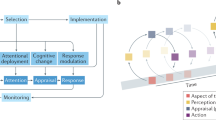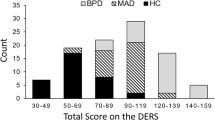Abstract
Emotional schemas are identified as the underlying mental structures associated with a wide range of emotional disorders. They may also be regarded as a transdiagnostic construct. However, the implications of specific emotional schemas on emotion regulation are not clear. In this sense, this study aims to explore how emotional schemas relate to emotional regulation and symptomatology. For this purpose, 416 (Mage = 20.86, SD = 5.22) individuals fulfilled self-reported questionnaires which were analyzed in a cross-sectional design. Results showed that emotional schemas were correlated with emotion regulation. Furthermore, emotional invalidation, non-acceptance, and uncontrollability were significant mediators of the relationship between emotional suppression and symptomatology. Emotional schemas may play a wider role in psychological disorders being a core issue to be addressed in psychotherapy. These results may enhance case conceptualization and psychological interventions.

Similar content being viewed by others
References
Aldao, A., & Nolen-Hoeksema, S. (2012). The influence of context on the implementation of adaptive emotion regulation strategies. Behaviour Research and Therapy, 50, 493–501
Aldao, A., Nolen-Hoeksema, S., & Schweizer. S. (2010). Emotion-regulation strategies across psychopathology: A meta-analytic review. Clinical Psychological Review, 30(2), 217–237. https://doi.org/10.1016/j.cpr.2009.11.004
Balsamo, M., Carlucci, L., Sergi, M. R., Klein, Murdock K, & Saggino A. (2015). The mediating role of early maladaptive schemas in the relation between co-rumination and depression in young adults. PLoS ONE, 10(10): e0140177. https://doi.org/10.1371/journal.pone.0140177
Barlow. H. D., & Colleagues (2017). The unified protocol for Transdiagnostic treatment of emotional disorders compared with diagnosis-specific protocols for anxiety disorders. A randomized clinical trial. JAMA Psychiatry, 4(9), 875–884. https://doi.org/10.1001/jamapsychiatry.2017.2164
Barreira, J. (2016). Relações entre dificuldades de processamento emocional, regulação emocional, necessidades psicológicas, sintomatologia e bem-estar/distress. Master thesis in Faculty of Psychology of University of Lisbon [Relationship between emotional processing difficulties, emotional regulation, psychological needs, symptomatology and well-being/distress.] http://hdl.handle.net/10451/27559.
Batmaz, S., Ulusoy Kaymak, S., Kocbiyik, S., & Turkcapar, M. H. (2014). Metacognitions and emotional schemas: a new cognitive perspective for the distinction between unipolar and bipolar depression. Comprehensive psychiatry, 55(7), 1546–1555. https://doi.org/10.1016/j.comppsych.2014.05.016.
Butler, E. A., Egloff, B., Wlhelm, F. H., Smith, N. C., Erickson, E. A., & Gross, J. (2003). The social consequences of expressive suppression. Emotion, 3(1), 48–67. https://doi.org/10.1037/1528-3542.3.1.48
Byrne, B. M. (2010). Multivariate applications series. Structural equation modeling with AMOS: Basic concepts, applications, and programming (2nd ed.). Routledge/Taylor & Francis Group
Canavarro, M. C. (1999). Inventário de sintomas psicopatológicos –BSI. In M. R. Simões, M. Gonçalves, L. S. Almeida (Eds.), Testes e Provas Psicológicas em Portugal (Vol. II, pp.95–109). APPORT/SHO
Castelo-Branco, M., (2016). Relações entre regulação emocional, regulação da satisfação das necessidades psicológicas, bem-estar/distress psicológicos e sintomatologia. Master thesis in the Faculty of Psychology of University of Lisbon. [Relationships between emotional regulation, regulation of the satisfaction of psychological needs, psychological well-being/distress and symptomatology] http://hdl.handle.net/10451/25628.
Cisler, J. M., Olatunji, B. O., Feldner, M. T., & Forsyth, J. P. (2010). Emotion regulation and the anxiety disorders: An integrative review. Journal of Psychopathology and Behavioral Assessment, 32(1), 68–82. https://doi.org/10.1007/s10862-009-9161-1
D'Avanzato, C., Joormann, J., Siemer, M., & Gotlib, I. H. (2013). Emotion regulation in depression and anxiety: Examining diagnostic specificity and stability of strategy use. Cognitive Therapy and Research, 37(5), 968–980. https://doi.org/10.1007/s10608-013-9537-0
Derogatis, L. R. (1993). The Brief Symptom Inventory (BSI): Administration. National Computer Systems, Minneapolis, MN, USA: Scoring and Procedures Manual.
Edwards, E., & Wupperman, P. (2019). Research on emotional schemas: A review of findings and challenges. Clinical Psychologist, 23(1), 3–14. https://doi.org/10.1111/cp.12171.
Edwards, E. R., Micek, A., Mottarella, K., & Wupperman, P. (2017). Emotion ideology mediates effects of risk factors on alexithymia development. Journal of Rational-Emotive and Cognitive Behavior Therapy, 35(3), 254–277. https://doi.org/10.1007/s10942-016-0254-y
Elliott, R., Watson, J. C., Goldman, R. N., & Greenberg, L. S. (2004). Learning emotion-focused therapy: The process-experiential approach to change. American Psychological Association
Faustino, B. (2021). Transdiagnostic perspective on psychological inflexibility and emotional dysregulation. Behavioural and Cognitive Psychotherapy, 49(2), 233–246. https://doi.org/10.1017/S1352465820000600.
Faustino, B. & Vasco. A. B. (2020a). Schematic functioning, interpersonal dysfunctional cycles and cognitive fusion in the complementary paradigmatic perspective: Analysis of a clinical sample. Journal of Contemporary Psychotherapy, 1(50), 47–55. https://doi.org/10.1007/s10879-019-09422-x
Faustino, B. & Vasco. A. B. (2020b). Early maladaptive schemas and cognitive fusion on the regulation of psychological needs. Journal of Contemporary Psychotherapy 1(50), 105–112. https://doi.org/10.1007/s10879-019-09446-3.
Faustino, B., & Vasco, A. B. (2020c). Relationships between emotional processing difficulties and early maladaptive schemas on the regulation of psychological needs. Clinical Psychology and Psychotherapy 27(6), 804–813. https://doi.org/10.1002/cpp.24643
Faustino, B., Fonseca, I., Antonio, A. B., Baião, M., Lopes, P., Oliveira (2019). Esquemas Precoces Mal-adaptativos e Dificuldades Emocionais na Regulação das Necessidades Psicológicas: Um estudo com indicadores comportamentais, Revista de Psicossomática ISSN - 2183-9344, 4. [Early Maladaptive Schemas and Emotional Difficulties on Regulation of Psychological Needs: A study with behavioral indicators]
Faustino, B., Vasco, A. B., Silva, A. N., & Marques, T. (2020). Relationships between emotional schemas, mindfulness, self-compassion and unconditional self-acceptance on the regulation of psychological needs. Research in Psychotherapy: Psychopathology, Process and Outcome, 23(2).https://doi.org/10.4081/ripppo.2020.442.
Goldfried, M. R. (2019). Obtaining consensus in psychotherapy: What holds us back? American Psychologist, 74(4), 484–496. https://doi.org/10.1037/amp0000365
Greenberg, L. S. (2015). Emotion-focused therapy: Coaching clients to work through their feelings. 2° ed. American Psychological Association
Gross, J. J. (2002). Emotion regulation: affective, cognitive, and social consequences. Psychophysiology, 39, 281–291. https://doi.org/10.1017/S0048577201393198.
Gross, J. J., & John, O. P. (2003). Individual differences in two emotion regulation processes: implications for affect, relationships, and well-being. Journal of Personality and Social Psychology, 85, 348–362. https://doi.org/10.1037/0022-3514.85.2.348.
Gross, J. & Oliver, J. (2003). Individual differences in two emotion regulation processes: Implications for affect, relationships, and well-being. Journal of Personality and Social Psychology, 85(2): 348–362. Doi:10.1.1.688.115. https://doi.org/10.1037/0022-3514.85.2.348
Hayes, A. F. (2013). Introduction to mediation, moderation, and conditional process analysis: A regression-based approach. New York: Guilford Press.
Krause, E. D., Mendelson, T., & Lynch, T. R. (2003). Childhood emotional invalidation and adult psychological distress: the mediating role of emotional inhibition. Child abuse & neglect, 27(2), 199–213. https://doi.org/10.1016/s0145-2134(02)00536-7.
Leahy, R. L. (2002). A model of emotional schemas. Cognitive and Behavioral Practice, 9, 177–190. https://doi.org/10.1016/s1077-7229(02)80048-7
Leahy, R. L. (2012). Introduction: Emotional Schemas, Emotion Regulation, and Psychopathology. International Journal of Cognitive Therapy, 5(4), 359–361. https://doi.org/10.1521/ijct.2012.5.4.359.
Leahy, R. L. (2015). Emotional schema therapy. Guilford Press.
Leahy, R. L, Tirch, D., & Napolitano, L. (2011). Emotion regulation in psychotherapy: A Practitioner’s guide. Guilford
Leahy, R. L., Wupperman, P., Edwards, E., Shivaji, S., & Molina, N. (2019). Metacognition and emotional schemas: Effects on depression and anxiety. International Journal of Cognitive Therapy, 12(1), 25–37. https://doi.org/10.1007/s41811-018-0035-8.
Manser, R., Cooper, M., & Trefusis, J. (2012). Beliefs about Emotions as a Metacognitive Construct: Initial Development of a Self-Report Questionnaire Measure and Preliminary Investigation in Relation to Emotion Regulation. Clinical Psychology and Psychotherapy, 19, 235–246. https://doi.org/10.1002/cpp.745.
Pallant, J. (2007). SPSS survival manual: A step by step guide to data analysis using SPSS for Windows (version 15). Berkshire: Open University Press, McGrow Hill Education.
Pinto-Gouveia, J. & Dinis. A. (2008). Leahy emotional schema scale-modified (LESS, Leahy, 2002). Mmanuscrito não publicado. Unpublished manuscript
Roelofs, J., Onckels, L., & Muris, P. (2013). Attachment quality and psychopathological symptoms in clinically referred adolescents: The mediating role of early maladaptive schema. Journal of Child and Family Studies, 22(3), 377–385. https://doi.org/10.1007/s10826-012-9589-x
Silberstein, L. R., Tirch, D., Leahy, R. L., & McGinn, L. (2012). Mindfulness, psychological flexibility and emotional schemas. International Journal of Cognitive Therapy, 5(4), 406–419. https://doi.org/10.1521/ijct.2012.5.4.406.
Silva, A.N., Matos, M., Faustino, B, Dias Neto, D. (2019). Portuguese version of the Leahy emotional schema scale (LESS). Poster presented in world congress of Behavioural and cognitive therapies at the CityCube, Berlin. https://doi.org/10.13140/RG.2.2.21835.41769. Available from: https:// www.researchgate.net/publication/344283057_Portuguese_version_of_the_Leahy_Emotional_Schema_Scale_LESS?channel=doi&linkId=5f63244d92851c14bc818b1c&showFulltext=true
Simpson, T., Jakupcak, M., & Luterek, J. A. (2006). Fear and Avoidance of Internal Experiences Among Patients With Substance Use Disorders and PTSD: The Centrality of Anxiety Sensitivity. Journal of Traumatic Stress, 19(4), 481–491. https://doi.org/10.1002/jts.20128.
Tamir, M. (2009). What do people want to feel and why? Pleasure and utility in emotion regulation. Current Directions Psychol Sci 18(2): 101–105. https://doi.org/10.1111/j.1467-8721.2009.01617.x
Tirch, D. D., Leahy, R. L., Silberstein, L. R., & Melwani, P. S. (2012). Emotional schemas, psychological flexibility, and anxiety: the role of flexible response patterns to anxious arousal. International Journal of Cognitive Therapy, 5, 380–391. https://doi.org/10.1521/ijct.2012.5.4.380.
Vasco, A. B. (2005). A conceptualização de caso no modelo de complementaridade paradigmática: variedade e integração. Psychologica, 40, 11–36
Vasco, A. B., Conceição, N., Silva, A. N., Ferreira, J. F., Vaz-Velho, C. (2018). O (meta)modelo de complementaridade paradigmática (MCP). In I. Leal (Ed.), Psicoterapias. Lisbon: Pactor. [Paradigmatic Complementarity Metamodel]
Vaz, F., & Martins, C. (2009). Diferenciação e Regulação Emocional na Idade Adulta: Tradução e validação de dois instrumentos de avaliação para a população portuguesa. Master thesis, Minho University. [Differentiation and Emotional Regulation in Adulthood: translation and validation of two assessment instruments for the Portuguese population]
Webb, T. L., Miles, E., & Sheeran, P. (2012). Dealing with feeling:a meta-analysis of the effectiveness of strategies derived from the process model of emotion regulation. Psychological Bulletin, 138, 775–808. https://doi.org/10.1037/a0027600.
Author information
Authors and Affiliations
Corresponding author
Additional information
Publisher’s Note
Springer Nature remains neutral with regard to jurisdictional claims in published maps and institutional affiliations.
Data Statement: Research data are not shared
Rights and permissions
About this article
Cite this article
Faustino, B., Vasco, A.B. Emotional schemas mediate the relationship between emotion regulation and symptomatology. Curr Psychol 42, 2733–2739 (2023). https://doi.org/10.1007/s12144-021-01560-7
Accepted:
Published:
Issue Date:
DOI: https://doi.org/10.1007/s12144-021-01560-7




